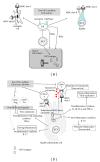Contradictory immune response in post liver transplantation hepatitis B and C
- PMID: 25215259
- PMCID: PMC4158295
- DOI: 10.1155/2014/814760
Contradictory immune response in post liver transplantation hepatitis B and C
Abstract
Hepatitis B and C often progress to decompensated liver cirrhosis requiring orthotopic liver transplantation (OLT). After OLT, hepatitis B recurrence is clinically controlled with a combination of hepatitis B immunoglobulin (HBIG) and nucleos(t)ide analogues. Another approach is to induce self-producing anti-hepatitis B virus (HBV) antibodies using a HBV envelope antigen vaccine. Patients who had not been HBV carriers such as acutely infected liver failure or who received liver from HBV self-limited donor are good candidate. For chronic HBV carrier patients, a successful response can only be achieved in selected patients such as those treated with experimentally reduced immunosuppression protocols or received an anti-HBV adaptive memory carrying donor liver. Hepatitis C virus (HCV) reinfects transplanted livers at a rate of >90%. HCV reinfected patients show different severities of hepatitis, from mild and slowly progressing to severe and rapidly progressing, possibly resulting from different adaptive immune responses. More than half the patients require interferon treatment, although the success rate is low and carries risks for leukocytopenia and rejection. Managing the immune response has an important role in controlling recurrent hepatitis C. This study aimed to review the adaptive immune response in post-OLT hepatitis B and C.
Figures

Similar articles
-
Molecular Mechanisms to Control Post-Transplantation Hepatitis B Recurrence.Int J Mol Sci. 2015 Jul 30;16(8):17494-513. doi: 10.3390/ijms160817494. Int J Mol Sci. 2015. PMID: 26263973 Free PMC article. Review.
-
Which patients respond best to hepatitis B vaccination after a hepatitis B virus-related liver transplantation?J Gastroenterol. 2013 Dec;48(12):1373-83. doi: 10.1007/s00535-013-0763-8. Epub 2013 Feb 23. J Gastroenterol. 2013. PMID: 23435670 Free PMC article.
-
Limited hepatitis B immunoglobulin with potent nucleos(t)ide analogue is a cost-effective prophylaxis against hepatitis B virus after liver transplantation.Transplant Proc. 2015 Mar;47(2):478-84. doi: 10.1016/j.transproceed.2014.11.029. Transplant Proc. 2015. PMID: 25769595
-
Predictive Factors for Successful Vaccination Against Hepatitis B Surface Antigen in Patients Who Have Undergone Orthotopic Liver Transplantation.Acta Med Okayama. 2019 Feb;73(1):41-50. doi: 10.18926/AMO/56457. Acta Med Okayama. 2019. PMID: 30820053
-
Hepatitis B: progress in the last 15 years.Liver Transpl. 2002 Oct;8(10 Suppl 1):S59-66. doi: 10.1053/jlts.2002.35782. Liver Transpl. 2002. PMID: 12362301 Review.
Cited by
-
Prevention and Treatment of Recurrent Hepatitis B after Liver Transplantation.J Clin Transl Hepatol. 2016 Mar 28;4(1):54-65. doi: 10.14218/JCTH.2015.00041. Epub 2016 Mar 15. J Clin Transl Hepatol. 2016. PMID: 27047773 Free PMC article. Review.
References
-
- Dusheiko G. Treatment of HBeAg positive chronic hepatitis B: interferon or nucleoside analogues. Liver International. 2013;33(supplement 1):137–150. - PubMed
-
- Kathryn MK, Corsa A, Liu Y. No detectable resistance to tenofovir disoproxil fumarate after 6 years of therapy in patients with chronic hepatitis B. Hepatology. 2014;59(2):434–442. - PubMed
-
- Tenney DJ, Rose RE, Baldick CJ, et al. Long-term monitoring shows hepatitis B virus resistance to entecavir in nucleoside-naïve patients is rare through 5 years-of therapy. Hepatology. 2009;49(5):1503–1514. - PubMed
Publication types
LinkOut - more resources
Full Text Sources
Other Literature Sources

